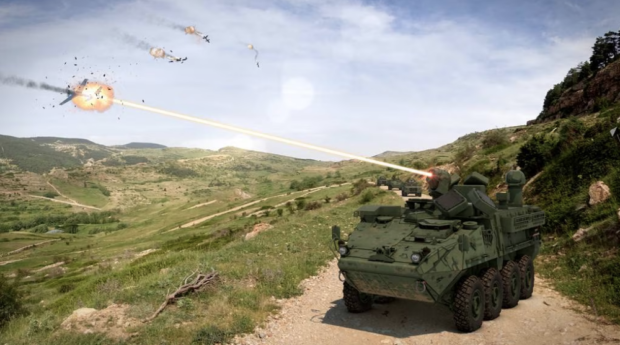The U.S. Army has concluded a live-fire test of the 50-kilowatt laser weapon variant of the service branch’s Stryker-based Short-Range Air Defense system at Yuma Proving Ground in Arizona.
Downed drones littered the battlefield at Yuma Proving Ground in Arizona during a live-fire test of the Stryker-based Short-Range Air Defense system prototypes with 50-kilowatt lasers, according to the director of Army’s Rapid Capabilities and Critical Technologies Office.
“When they got out on the range, they were knocking targets out of the sky, Group 1, Group 2, Group 3 [unmanned aircraft systems],” Lt. Gen. Robert Rasch said told Defense News in an interview. “Very, very effective.”
While the lasers made short work of drones, some challenges remain in taking out rockets, artillery and mortars, he said.
The Army is now receiving its first platoon-set of the systems, taking the first two of the Directed Energy Maneuver-SHORAD prototypes to Yuma earlier this year for training with soldiers. The third prototype is about to go into acceptance testing, according to Rasch, and the fourth will be delivered within the next couple of months.
Delivering the first platoon-set — four DE M-SHORAD prototypes — will complete RCCTO’s mission, but the office won’t stop there.
Developmental testing with soldiers will continue over the next quarter and in the fourth quarter of fiscal 2023, the Army will begin developing tactics, techniques and procedures for the systems, Rasch said.
“There’s a lot, when you look at fielding a capability, you don’t just field a technology, you have to figure out how to integrate that technology into a warfighting capability,” Rasch said.
The Army fielded its M-SHORAD system with a kinetic capability to Europe in response to an urgent operational need. “We’ve got kinetic M-SHORAD, we’ve got directed energy M-SHORAD, we’re just now getting short-range air defense back into our maneuver units. So they’re still figuring out the TTPs on how to fight that.”
And the Army also has to figure out the right mix of those systems and how it wants to use them in operations, he added.
Then RCCTO, in partnership with Army Test and Evaluation Command, will take the DE M-SHORAD into a user assessment beginning in the fourth quarter of FY23 through the first quarter of FY24.

U.S. Army air defenders with Alpha Battery, 5th Battalion, 4th Air Defense Artillery Regiment, reloads ammo during a M-SHORAD live fire Feb. 9 at Grafenwoehr
Photo by Pfc. Yesenia Cadavid/U.S. Army
Already the system has come a long way, Rasch said, compared to the prototypes the Army evaluated just a year ago.
The effort to put a laser on an M-SHORAD vehicle began in mid-2019, when the Army awarded KBR subsidiary Kord Technologies a contract to integrate a laser system onto the vehicle. Kord, as the program’s prime contractor, subsequently awarded subcontracts to Northrop Grumman and Raytheon Technologies teams to develop the laser module.
The competition between Northrop and Raytheon to produce the laser module was intended to culminate in a shoot-off between the two teams. Kord and the Army then planned to agree on a winner and proceed with integration of the selected module onto three more Strykers to make a platoon’s worth of directed energy SHORAD systems.
Top Photo: Raytheon’s 50-kilowatt laser – Artist rendering courtesy of Raytheon

